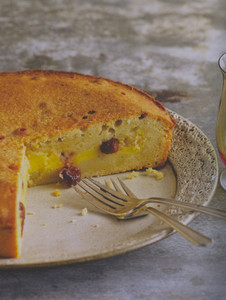Basque (2) - the food
- rosemary
- Nov 19, 2020
- 7 min read
"As far as the true regional dishes are concerned, Basque and Béarnaise cooking is easier to follow in manner than to the letter" Elizabeth David

I suspect I was probably somehow not in the mood for cooking books yesterday, or indeed the first of the days I started flicking through The Basque Book. I still maintain that a lot of it is restaurant food, and beyond my skills, or too difficult because of acquiring the right ingredients, but there's got to be something one can cook from it - or from elsewhere - to showcase Basque food surely?
Well there is the daunting news that:
San Sebastian has for some years now been the prime destination of food lovers from all over the world, as the centre with the greatest concentration of trail-blazing innovative Michelin-starred chefs." Claudia Roden - The Food of Spain
There are more Michelin starred restaurants there than anywhere else in the world, except perhaps Kyoto. And that still seems to be true, with people like Alexandra Raij and her husband transporting that stardom elsewhere. When Paul Bocuse apparently gathered two Basque chefs to his restaurant in Lyon he began a trend:
"It was the start of what was to become a national movement to renovate old traditional dishes and create new ones based on regional products, and was the first Spanish alta cucina (haute cuisine)" Claudia Roden - The Food of Spain

Top of the list are the the oh so trendy pintxos (tapas) that mean when you try to find a picture of something as general as 'Basque food' what you get are lots and lots of pictures of pintxos. And when it comes to the book this is a good place to start in order to demonstrate how simple really is not easy. At left if a very simple pintxos called Gilda.
"It is traditionally layered to suggest a woman's figure, specifically that of Rita Hayworth in the 1946 movie Gilda: an olive for the head, the peppers for the arms, the anchovy and another olive on the bottom for more curves. ... Stacked just right, the ingredients also look like a Basque dancer, arms out and embracing the sky." Alexandra Raij - The Basque book
There are just four ingredients, and therein lies the rub. So okay we can replace the Manzanilla olives with other green olives - indeed you may even be able to get some. Ditto for the specific anchovies named here, but the peppers - now I'm not so sure about them - pickled guindilla peppers. Maybe I'm wrong and they are sitting on the shelves in Woolworths or Coles. I could obviously make a good imitation, and maybe one should, but it won't be the 'real' thing will it? And I checked - this is indeed a very traditional pintxos. And here are a few others:
Anchovies are big here, as are chorizo, eggs, shellfish, olives and Spanish and French ham - Bayonne, Iberico and Serrano - all available here. Yes - easy and yet not. I can imagine that it's quite competitive to produce the best, most innovative versions in a hot-house culinary town like San Sebastian.
But this isn't really country cooking is it? Although these days we can mess with that too. I wonder if the world that Elizabeth David described back in 1960 in French Provincial Cooking in her section on the cooking of the Basque country and the Béarnais which is just next door, still exists?
"Peppers and onions are sizzling gently in a big frying pan, the goose dripping which they are cooking giving off its unmistakable smell. As squat, round-bellied earthen pot, blackened with use, containing beans and salt pork and cabbage, seems to be for ever on the simmer. A string of wrinkled, dried, dark red peppers hangs from the ceiling alongside a piece of roughly cut ham; a bunch of little red sausages and pitcher of yellow wine are on the table." Elizabeth David
Well maybe - the picture at the top of the page is a visual impression of that kind of dish perhaps, and it comes at the beginning of the recipe section of my Basque Book. There do indeed seem to be a small number of ingredients that pop up over and over again in the book's recipes and elsewhere when you search for Basque food.
"In the Basque area bell peppers are served with practically everything. ... Basque peppers are smaller than most, and somewhat sweeter." Diane Holuigue - France, a Culinary Journey

And some seem to be very specific to the area. The most famous dish here is Pipérade - eggs with tomatoes and peppers, and yet curiously there is no recipe for this in The Basque Book. The dish shown here is from Claudia Roden's The Food of Spain and my France, a Culinary Journey also features it in its much smaller selection of dishes, as do Elizabeth David and Robert Carrier in his Great Dishes of the World. It was once a very well known Basque dish. I wonder - has it fallen out of fashion? And if so, why?
But moving on - onions. Oh yes - they have to be the right kind of onion, and I'm a little unclear about which is best to substitute - red onions maybe? I mentioned the onion/pepper marmalade kind of thing - sofrito - yesterday, but there are plenty of other dishes which feature onions, leeks and garlic of course. Lots of garlic. They even make garlic soup, which is shown here with some pipérade in the background.

Fish though is the real thing with salt cod playing a special role. Well traditionally this was a cuisine of the poor, of fishermen who travelled far to find the cod and who therefore needed to preserve their catch through the seasons. Some say they even went as far as Canada long before Christopher Columbus discovered the Caribbean islands. They were whalers too.
"Traditionally shepherds and fishermen, the Basques were once the world's greatest whalers. (They were also pirates and smugglers too, given half a chance." Diane Holuigue - France, a Culinary Journey
The most traditional dish for the salt cod is Bakalao al Pil Pil which is basically poached salt cod in olive oil. And here is Alexandra Raij's typically somewhat off-putting introduction:
"This elusive, iconic Basque dish is a lesson in food science and sauce making. When done well, it is also the most elegant dish I have ever seen or tasted, but when prepared without care or with less than extraordinary ingredients, it can easily be off-putting. You must watch, listen, and learn from your mistakes with this dish. You will become one with it only when you have made it a dozen times and have learned your way around everything that can go wrong with it."
Elizabeth David can be a bit like this sometimes, but she usually follows up with something really simple. Alexandra Raij's recipe covers two pages. Besides - 'extraordinary ingredients' - where am I going to find them, and can I afford them anyway? Here are some versions I found - with hers on the left. I must say I like the look of the rather more homely looking version at the bottom. But because of that introduction I would be a bit nervous about trying hers.
The other widely touted Basque fish dish is a stew called Marmitako. Interestingly Alexandra is not a fan, finding it 'excessively rich', so she has adapted it and made a 'leaner-cleaner' version, that still takes two pages to cover. No picture of this one from her but I found some others, all of which look very different I have to say. The fish, by the way is tuna:

Her book does not contain many meat recipes, even though the Basque country is famous for the quality of its lamb. Apparently most of it is exported for the income. What pictures I did see were for fairly basic grilled and roasted meats, often in the very Basque, men only, eating clubs, where men meet each week over an enormous meal drunk with cider - the top Basque drink.

Very sexist, but this tradition has yet to die.
Beans are also very important - as you would expect with a peasant kind of cuisine. But the beans in question, of course, are not your normal bean - they are from Tolosa and are red. Claudia Roden implies that they are the same as turtle beans. The most famous dish is a stew with peppers, leeks, cabbage pork and ham - so not a dish for two people. Alexandra calls hers Alubias con Sacramentos - and here it is, with one other example from the net. This time, I have to say, hers looks more tempting and is maybe worth a try when winter comes around, even though I don't have access to guajillo or choricero peppers. or choricero pepper paste for that matter.
What about dessert? Now this looks worth attempting. It's called Pastel Vasco and is really a shortbread crust surrounding a custard, which is often studded with cherries. Mind you this recipe goes for three pages, so maybe not. Although my France, a Culinary Journey has a recipe that is much shorter! Hers is on the left. actually looks a bit stodgier than the one on the right.
So there you have it - fundamentally a fairly simple peasant cuisine, featuring the simplest of ingredients - fish, lamb, beans, garlic, peppers, onions - originally cooked in fairly simple, if slow ways, which has been transformed to the haute cuisine star of the entire world, and in the process become perhaps a bit too difficult for mere mortals like me. Well in this book anyway.
I have never quite made it to this area of France. We almost got there last time, so now I shall most likely never see it. It does look beautiful though. This is the port of St Jean de Luz, on the French side of the border.































Comments